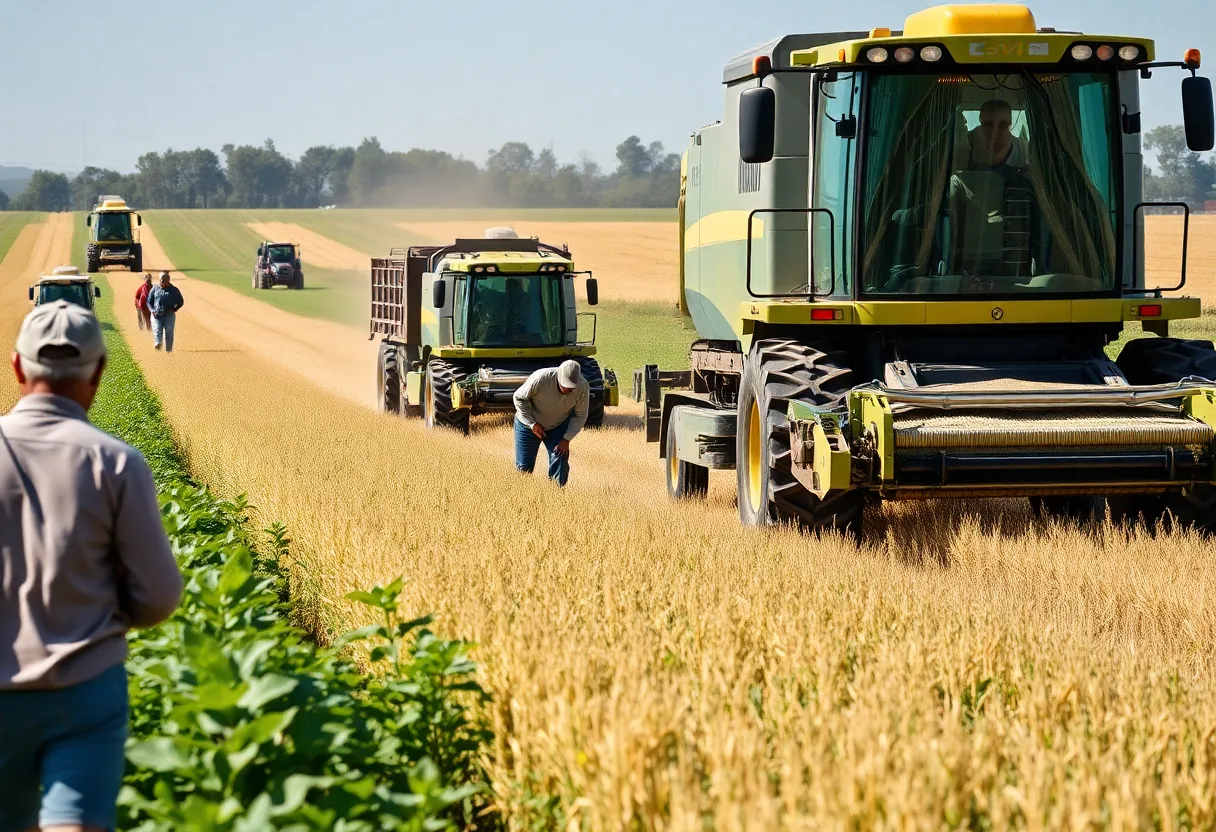California, August 26, 2025
News Summary
California agriculture is facing a severe labor shortage exacerbated by immigration raids and a push for automation. With nearly 88,000 agricultural jobs unfilled each year in the U.S., farmers struggle to maintain operations. Some, like Larry Jacobs, are turning to robots to cope but face regulatory hurdles. Immigration policies further threaten labor supply, as many workers fear arrest. With an aging farmer demographic, automation could attract younger workers, but critics warn it cannot fully replace human labor. The ongoing situation raises concerns about the future of food security in California.
California Faces Agricultural Labor Crisis Driven by Immigration Raids and Automation Push
California farmers, particularly in Central California, are confronting a severe labor shortage exacerbated by recent immigration raids. The impact is significant; nearly 88,000 agricultural jobs are unfilled annually in the U.S., according to data from the Bureau of Labor Statistics. Farmers like Larry Jacobs are struggling to find enough laborers to work their fields, leading many to seek solutions through automation and technology.
To cope with the labor shortage, Jacobs has turned to robots, allowing him to maintain his farm with only half the workforce he previously relied on. Despite this technological shift, California state regulations currently hinder the use of autonomous machines without human oversight, impacting the efficiency of farming operations.
Changing Legal Landscape for Automation
Industry leaders recognize the need to update state legislation that governs autonomous agricultural machinery, originally crafted in the 1970s. Tyler Niday, CEO of Bonsai Robotics, highlights a growing push to rewrite these outdated regulations to better accommodate modern technological advancements.
The average age of farmers is now 58 years, which opens the door for introducing automation as a way to attract a younger generation to the agricultural sector. Bonsai Robotics’ machines are priced at around $13,000, significantly cheaper than traditional full-sized tractors, which can cost up to $80,000, presenting an appealing option for farmers facing tight budgets.
Impact of Immigration Raids on Labor Supply
The ramifications of immigration enforcement are profound, with community organizers reporting at least 35 arrests in Ventura County farms alone. Many farmers have observed that workers are staying home due to heightened fears of arrest following these raids. A significant portion of U.S. crop farmworkers—about 42%—lack work authorization, and California hosts the highest percentage of unauthorized workers in the nation.
Agriculture Secretary Brooke Rollins has stated that the administration aims to address labor shortages through a dual approach of promoting automation while reforming existing immigration policies. Rollins suggested that groups such as able-bodied adults on Medicaid could become potential candidates for agricultural jobs. This proposal, however, has faced backlash from California’s agricultural community, which finds it misguided and insulting.
The Viability of Automation in Agriculture
Despite the push for automation, critics argue that relying solely on technology for agricultural labor may not be practical. Previous experiences in states like Georgia and Alabama have shown that automation cannot fully replace the human workforce. Many agricultural tasks, particularly those involving the delicate handling of crops like strawberries, still necessitate human labor.
Manuel Cunha from the Nisei Farmers League noted that previous efforts to fill farm jobs with welfare recipients led to significant failures and crop losses. Moreover, the Trump administration has sought to implement temporary visa programs aimed at bringing in foreign workers to support agricultural labor needs.
Concerns Over Future Food Security
Current immigration policies are under scrutiny for their potential threat to food security, especially as they may alienate the immigrant workforce that is crucial for maintaining agricultural productivity. Secretary of Homeland Security Kristi Noem has acknowledged the link between national food policy and national security, reinforcing the need for dialogue about legalizing essential migrant workers in agriculture and service sectors to ensure food supply stability.
As California farmers navigate these challenges, the hope is that advancements in automation, paired with a more inclusive immigration policy, may provide a pathway to securing the future of its agricultural industry.
FAQs
What is causing the labor shortage in California agriculture?
The labor shortage is primarily driven by recent immigration raids, which have resulted in many agricultural workers staying home due to fears of arrest.
How many agricultural jobs remain unfilled each year in the U.S.?
Approximately 88,000 agricultural jobs are unfilled annually across the United States.
What innovations are farmers like Larry Jacobs pursuing to address labor shortages?
Farmers are turning to automation and technology, utilizing robots to assist with farming tasks and reduce reliance on human labor.
What are the legal implications of using automation in California agriculture?
California’s regulations currently prohibit the use of autonomous machines without human oversight, leading to calls for updating these laws.
What percentage of U.S. crop farmworkers lack work authorization?
About 42% of U.S. crop farmworkers are reported to lack work authorization, with California accounting for the highest share.
Key Features of Automation in Agriculture
| Feature | Details |
|---|---|
| Labor Shortage | 88,000 agricultural jobs remain unfilled each year in the U.S. |
| Automation Solutions | Bonsai Robotics machines cost around $13,000, offering a cost-effective alternative to traditional tractors. |
| Current Regulations | California law requires human oversight for the use of autonomous machines. |
| Impact of Immigration Raids | At least 35 arrests reported in Ventura County farms, leading to increased fear and worker absenteeism. |
| Legalizing Workers | Current policies are seen as a threat to food security by alienating vital migrant labor. |
Deeper Dive: News & Info About This Topic
- Los Angeles Times: Trump Administration Agricultural Secretary
- Farmonaut: California’s Agricultural Labor Crisis
- Future Farming: Agricultural Robotics Market
- CBS News: Farming Automation and Migrant Workers
- Ag Proud: California Dairy Innovates with Automation
- Wikipedia: Agriculture in the United States
- Google Search: California Agricultural Labor Crisis
- Encyclopedia Britannica: Agriculture
- Google News: California Agricultural Labor Crisis
- Google Scholar: Agricultural Automation

Author: STAFF HERE HOLLYWOOD
The Hollywood Staff Writer represents the experienced team at HEREHollywood.com, your go-to source for actionable local news and information in Hollywood, Los Angeles County, and beyond. Specializing in "news you can use," we cover essential topics like product reviews for personal and business needs, local business directories, politics, real estate trends, neighborhood insights, and state news affecting the area—with deep expertise drawn from years of dedicated reporting and strong community input, including local press releases and business updates. We deliver top reporting on high-value events such as the Hollywood Bowl summer concerts, the Hollywood Christmas Parade, film premieres at TCL Chinese Theatre, and festivals at the Magic Castle. Our coverage extends to key organizations like the Hollywood Chamber of Commerce and Visit Hollywood, plus leading businesses in entertainment, dining, and tourism that define the local economy. As part of the broader HERE network, including HERELosAngeles.com, HEREBeverlyHills.com, HEREAnaheim.com, and HEREHuntingtonBeach.com, we provide comprehensive, credible insights into Southern California's dynamic landscape.





